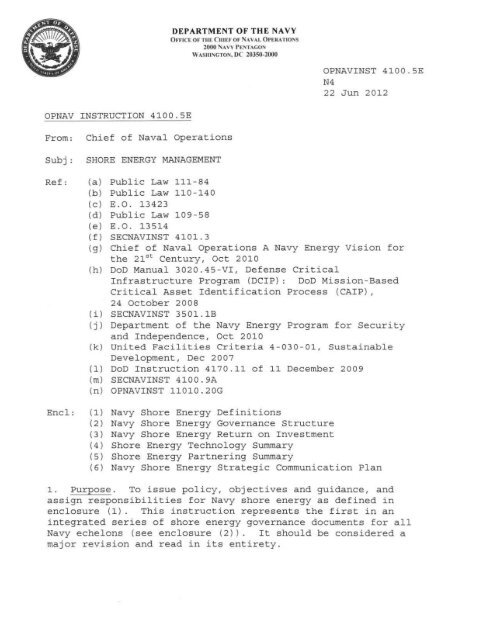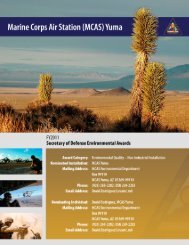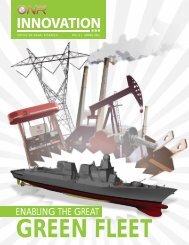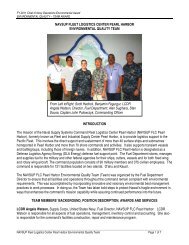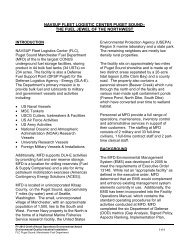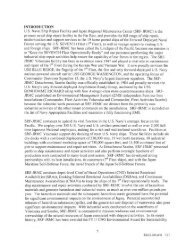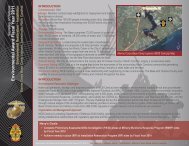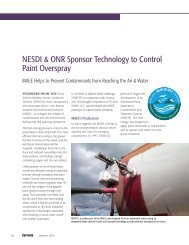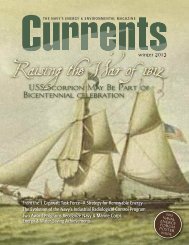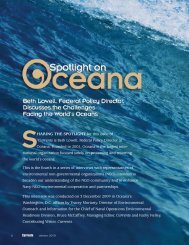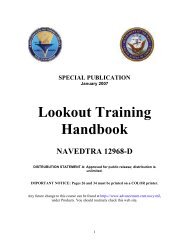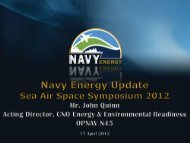opnavinst 4100.5 e - Navy Issuances
opnavinst 4100.5 e - Navy Issuances
opnavinst 4100.5 e - Navy Issuances
Create successful ePaper yourself
Turn your PDF publications into a flip-book with our unique Google optimized e-Paper software.
DEPARTMENT OF THE NAV Y<br />
OFFICE Of TH £. CHIEf Of NAVAL OPERATIONS<br />
2000 NAVY PENTAGON<br />
WASHINGTON, DC 20350-2000<br />
OPNAVINST <strong>4100.5</strong>E<br />
N4<br />
22 Jun 2012<br />
OPNAV INSTRUCTION <strong>4100.5</strong>E<br />
From:<br />
Subj:<br />
Chief of Naval Operations<br />
SHORE ENERGY MANAGEMENT<br />
Ref: {a) Public Law 111-84<br />
(b) Public Law 110 - 140<br />
(c) E.O. 13423<br />
{d) Public Law 109- 58<br />
(e) E. O. 13514<br />
(f) SECNAVINST 4101.3<br />
(g) Chief of Naval Operations A <strong>Navy</strong> Energy Vision for<br />
the 21st Century, Oct 2010<br />
{h) DoD Manual 3020.45-VI, Defense Critical<br />
Infrastructure Program (DCIP) : DoD Mission-Based<br />
(i)<br />
( j )<br />
(k)<br />
( 1)<br />
(m)<br />
(n)<br />
Critical Asset Identification Process (CAIP),<br />
24 October 2008<br />
SECNAVINST 3501.1B<br />
Department of the <strong>Navy</strong> Energy Program for Security<br />
and Independence, Oct 2010<br />
United Facilities Criteria 4-030-01, Sustainable<br />
Development, Dec 2007<br />
DoD Instruction 4170.11 of 11 December 2009<br />
SECNAVINST 4100.9A<br />
OPNAVINST 11010.20G<br />
Encl:<br />
{1)<br />
( 2)<br />
( 3)<br />
( 4)<br />
( 5)<br />
( 6)<br />
<strong>Navy</strong> Shore Energy Definitions<br />
<strong>Navy</strong> Shore Energy Governance Structure<br />
<strong>Navy</strong> Shore Energy Return on Investment<br />
Shore Energy Technology Summary<br />
Shore Energy Partnering Summary<br />
<strong>Navy</strong> Shore Energy Strategic Communication Plan<br />
1. Purpose. To issue policy, objectives and guidance, and<br />
assign responsibilities for <strong>Navy</strong> shore energy as defined in<br />
enclosure (1) . This instructi on represents the first in an<br />
integrated series of shore energy governance documents for all<br />
<strong>Navy</strong> echelons (see enclosure (2)). It should be considered a<br />
major revision and read in its entirety.
OPNAVINST <strong>4100.5</strong>E<br />
22 Jun 2012<br />
2. Cancellation. OPNAVINST 4100 . 5D and OPNAVINST 4100.6B.<br />
3. Policy. <strong>Navy</strong> policy is to ensure energy security and legal<br />
compliance, per references (a) through (f), by increasing<br />
infrastructure energy efficiency and integrating cost-effective<br />
and mission-compatible a lternative energy t echnologies while<br />
providing reliable energy supply ashore. The <strong>Navy</strong> shall:<br />
a. Ensure Energy Security as a Strategic Imperative. As<br />
stated in reference (g), energy security is a critical component<br />
of national security. Energy security is having assured access<br />
to reliable supplies of energy and the ability to protect and<br />
deliver sufficient energy to meet operational needs afloat and<br />
ashore. Shore energy security for <strong>Navy</strong> is the mitigation of<br />
vulnerabilities related to the electrical grid, including<br />
outages from natural disaster, accident and physical and cyber<br />
attack. To increase shore energy security, <strong>Navy</strong> shall:<br />
(1) Provide reliable, resilient, and redundant missioncritical<br />
energy sources to <strong>Navy</strong> tier I and II task critical<br />
assets (TCA) ashore, per references (a), {h) and (i}.<br />
(2) Reduce vulnerabilities tied to the electrical grid,<br />
including outages from natural disaster, accident, and physical<br />
and cyber attack, by lowering energy dependence and integrating<br />
energy security technologies which enable greater control of<br />
energy supply and distribution, per reference (j) .<br />
b. Achieve Legal Compliance for Shore Energy and<br />
Sustainability<br />
(1) Achieve a 30 percent facility energy intensity<br />
reduction by 2015, per references (b) through (e).<br />
(2 } Reduce consumption of fossil fuel and increase the<br />
use of alternative fuels by the <strong>Navy</strong>'s non-tactical vehicle<br />
(NTV} fleet as mandated by references (b) , (c) , and (d) . To the<br />
maximum extent possible, NTVs powered by a l ternative fuels shall<br />
be cost- effective over their lifecycle when compared to NTVs<br />
powered by fossil fuels.<br />
(3) Increase water efficiency of shore infrastructure,<br />
per references (b ) and (d) .<br />
2
OPNAVINST <strong>4100.5</strong>E<br />
22 Jun 2012<br />
(4 ) Reduce greenhouse gas emissions as required by<br />
refere nce (c) .<br />
(5) Produce, procure and consume renewable energy as<br />
required by references (a ), (c ) and (d ) .<br />
(6) Complet e annual , comprehensive ene rgy and water<br />
evaluations for approximately 25 percent of covered facilities<br />
as defined in enclosure (1) and per reference (b ) .<br />
{7) I nstall, to t he maximum extent practicabl e , adva nced<br />
metering devices on shore facilities that measure electricity,<br />
natural gas, and steam consumption, per references {d) and (e).<br />
(8} Promote sustai nable development for all new<br />
footprint and major recapitalization projects ashore, per<br />
references (c) and (k) .<br />
c. Achieve Department of the <strong>Navy</strong> (DON} Shore Energy Goals.<br />
<strong>Navy</strong> will use the most cost effective manner, per reference {f),<br />
to meet DON shore energy goals, per ref erence (j). They are:<br />
(1 } Fifty percent ashore consumption reduction by 2020.<br />
(2} Fifty percent total ashore energy from alternative<br />
sources by 2020.<br />
(3} Fifty percent of ins tallat ions net -zero consumers<br />
(as defined in enclosure (1 }} by 2020.<br />
(4 ) Fifty percent reduction in petroleum used in the<br />
commercial v e hicle fleet by 201 5 .<br />
4 . Guiding Principles. Shore energy security and legal<br />
compliance shall be achieved thr ough t hree key components:<br />
a. Energy Efficiency. <strong>Navy</strong> will increase the energy<br />
efficiency of existing facilities and utility systems as the<br />
most cost-effective way to reduce energy consumption and<br />
increase impact of current and future renewable energy<br />
generation sources .<br />
3
OPNAVINST 4100.SE<br />
22 Jun 2012<br />
b. Renewable Energy and Sustainability. <strong>Navy</strong> will<br />
integrate mission compatible and cost-effective renewable energy<br />
sources, based on an analysis of operational impacts and energy<br />
return on investment (eROI ), per enclosure (3) . All new<br />
construction and major renovation projects will meet high<br />
performance and sustainable building design and construction<br />
standa rds (Leadership in Energy and Environmental Design (LEED®)<br />
or equivalent), per reference (k), or current DON directed<br />
level, whichever is greater at time funds are programmed.<br />
c. <strong>Navy</strong> Culture and Behavior. Invest in energy management<br />
systems and personnel to provide leaders with building-level<br />
transparency of energy consumption to further drive efficiency<br />
beyond infrastructure related improvements at the command and<br />
functional levels, per reference (g).<br />
s . Strategy. To accomplish the <strong>Navy</strong>' s goals as set forth in<br />
this policy while allowing for local differences, the <strong>Navy</strong> shall<br />
implement a consistent programmatic approach centered on the<br />
following strategies:<br />
a. Establish a tailored energy consumption reduction goal<br />
for each installation, based on its unique energy situation.<br />
These tailored goals will aggrega te to a SO percent total energy<br />
consumption reduction across <strong>Navy</strong>.<br />
b. Optimize viable <strong>Navy</strong>-wide or region-wide technical<br />
solutions without precluding local innovative actions.<br />
c. Transform the <strong>Navy</strong> shore energy culture, comprised of<br />
three components:<br />
(1) Technical solutions that provide energy consumption<br />
data so leaders and individuals can modify behavior.<br />
(2) Operational and process changes that reduce energy<br />
consumption and costs.<br />
(3) Awareness of conservation and the valuing of energy<br />
as a strategic resource .<br />
4
OPNAVINST <strong>4100.5</strong>E<br />
22 Jun 2012<br />
d. Link infrastructure maintenance and recapitalization<br />
systems with energy management and distribution systems to<br />
realize energy efficiency through improved requirements<br />
identification, demand management, and condition-based<br />
maintenance.<br />
e. Utilize a "Watch-Partner-Lead" framework to assess new<br />
technologies, as described in enclosure (4).<br />
f. Look externally to seek win-win partnership<br />
opportunities with energy stakeholders (other Government,<br />
utilities, industry, developers, and academia), as described in<br />
enclosure (5).<br />
g. Execute shore energy communications at all echelons ,<br />
both internally and externally, following the <strong>Navy</strong> Shore Energy<br />
Strategic Communication Plan, as described in enclosure (6) .<br />
6. Action<br />
a. Enabling Systems (Infrastructure and Initiatives) . To<br />
facilitate the most effective and efficient achievement of the<br />
<strong>Navy</strong>'s shore energy goals, the <strong>Navy</strong> will utilize enabling<br />
infrastructure and initiatives, to include : advanced metering<br />
infrastructure (AMI) , per references (b) and (d); annual<br />
facility energy audits, per reference (b); energy managers<br />
assigned to each <strong>Navy</strong> region and installation, per references<br />
(b), (d), and (l); and establish smart building and base energy<br />
management operating systems, per references (d) and (1 ) . These<br />
new enabling energy systems will be integrated into facility<br />
management systems to ensure the cost-effective level of<br />
recapitalization and maintenance occurs such that energy savings<br />
are not only achieved, but also sustained.<br />
(1) Commander, <strong>Navy</strong> Installations Command (CNIC) shall<br />
utilize these enabling systems when analyzing performance<br />
against energy goals and when developing requirements for energy<br />
and sustainability initiatives.<br />
(2) Naval Facilities Engineering Command (NAVFACENGCOM)<br />
shall track and monitor the effectiveness of the enabling<br />
systems, and periodically make performance improvement and other<br />
technical recommendations to CNIC.<br />
5
OPNAVINST <strong>4100.5</strong>E<br />
22 Jun 2012<br />
b. Reporting and Analysis. Regional commanders and<br />
installation commanding officers shall, utilizing NAVFACENGCOM<br />
support as described in enclosure (2), collect <strong>Navy</strong> shore energy<br />
data and submit to CNIC headquarters (HQ) quarterly , within 6 0<br />
days of quarter completion. CNIC HQ shall then submit within 30<br />
days of receipt to Chief of Naval Operations (CNO ) (Director,<br />
Shore Readiness Division (OPNAV N46)). Once final , these<br />
completed reports shall be distributed to all regions ,<br />
installations, systems commands (SYSCOMs ) , and supported<br />
commands so energy metrics are transparent at all echelons.<br />
Progress will be reported on:<br />
(1 ) Shore energy progress data (as defined in enclosure<br />
(1)), per reference (b) , by installation, tenant, region, and<br />
SYSCOM. Progress against the established baseline will be<br />
tracked at the installation level and rolled up to the region<br />
and enterprise level.<br />
(2 ) Renewable energy generation, per reference (a ) , by<br />
region and installation.<br />
(3) Progress towards annual net-zero energy use<br />
requirements, per reference (m) .<br />
(4) Annual <strong>Navy</strong> NTV fleet petroleum consumption (in<br />
million gallons gasoline equivalents (MGEG ) , per references (b )<br />
and (c) ; alternative fuel consumption (in MGEG ) , per reference<br />
(c) i acquisition of alternative-capable vehicles, per reference<br />
(d ) i and number of alternative fueling stations , per reference<br />
( d ) .<br />
(5) Percentage of <strong>Navy</strong> tier I and II TCA, per references<br />
(h ) and (i } I which have been assessed for critical energy system<br />
vulnerabilities and assigned potential mitigation strategies.<br />
(6 ) Percentage of covered facilities evaluated for<br />
energy and water reduction opportunities, per reference (b ) .<br />
(7 ) Annual progress on AMI deployment to installations,<br />
per references (b ) and (d ) .<br />
c. Shore Energy Investments (Planning and Selection) . All<br />
shore energy investments (as defined in enclosure (1}) 1<br />
6
OPNAVINST <strong>4100.5</strong>E<br />
22 Jun 2012<br />
regardless of funding source, will be planned, programmed,<br />
budgeted, and executed based on fact-based and defensible<br />
criteria which maximize the eROI to the <strong>Navy</strong>. Data reporting<br />
shall validate the actual result achieved against the planned<br />
output.<br />
(1) CNIC shall ensure shore energy investments are<br />
identified and prioritized without regard to funding source or<br />
maintenance unit identification code (see paragraph 4, enclosure<br />
(1)). Inputs for the Energy Conservation Investment Program<br />
(ECIP), third-party financing funded through annual utility<br />
savings , as well as sustainment, restoration and modernization<br />
funds for <strong>Navy</strong> shore energy will be collected into a single<br />
annual energy requirements listing and prioritized solely based<br />
on eROI criteria, enclosure (3), which includes the CNO<br />
Director, Assessments Division (OPNAV N81 ) approved combination<br />
of financial and non-financial energy factors. From this annual<br />
master energy requirements list, CNIC shall determine the best<br />
funding mechanism and methodology to maximize shore energy<br />
investment, based on project characteristics and localized cost<br />
of energy.<br />
(2) NAVFACENGCOM shall ensure Major Maintenance and<br />
Repair Program energy efficiency investments , which are<br />
submitted for funding by targeted energy investment funds, are<br />
prioritized for funding solely based on the eROI criteria.<br />
Traditional and energy Major Maintenance and Repair Program<br />
shall be separate and distinct.<br />
(3) Other region and installation tenant commands,<br />
detachments, and <strong>Navy</strong> Working Capital Fund (NWCF) entities<br />
(Space and Naval Warfare Systems Command, NAVFACENGCOM, Naval<br />
Sea Systems Command, Naval Air Systems Command) will align their<br />
shore energy investments, regardless of funding source or<br />
maintenance unit identification code, with the eROI<br />
prioritization criteria and submit project information to CNIC,<br />
v ia the installation commanding officer. This is required to<br />
comply with Federal law, per reference (b), and allow for<br />
inclusion in the annual Shore Energy Implementation Plan update.<br />
7
OPNAVINST <strong>4100.5</strong>E<br />
22 Jun 2012<br />
7. Roles and Responsibilities<br />
a. CNO, through the Deputy Chief of Naval Operations for<br />
Fleet Readiness and Logistics (N4 ), plans and programs for <strong>Navy</strong><br />
energy to ensure resources are effectively and efficiently<br />
employed to meet validated requirements.<br />
(1) Director, Energy and Environmental Readiness<br />
Division (OPNAV N45 ) , shall:<br />
(a) Serve as the CNO's single point of contact,<br />
responsible for <strong>Navy</strong> energy issues including, but not limited<br />
to, energy efficiency, conservation, alternative energy, and<br />
energy innovation for both tactical and shore forces.<br />
(b ) Provide coordination, integration and oversight<br />
of tactical and shore energy products and issues, to include<br />
assessment of the resourcing and execution of <strong>Navy</strong> energy<br />
programs.<br />
strategy.<br />
(c) Develop and update the comprehensive <strong>Navy</strong> energy<br />
(d ) Coordinate with budget submitting offices and<br />
resource sponsors.<br />
(e ) Develop metrics, processes and frameworks to<br />
analyze energy investments.<br />
(2) OPNAV N46, in support of OPNAV N45, shall maintain<br />
overall responsibility for <strong>Navy</strong> shore energy, and shall:<br />
(a) Support the <strong>Navy</strong> Energy Coordination Office.<br />
(b ) Support Secretary of the <strong>Navy</strong> (SECNAV) Shore<br />
Energy Policy Board, per reference (f).<br />
(c) Set policies and program resources necessary for<br />
execution of goals as set by the CNO annually.<br />
investments.<br />
(d ) Develop programming guidance for shore energy<br />
8
OPNAVINST <strong>4100.5</strong>E<br />
22 Jun 2012<br />
(e) Coordinate with CNIC and NAVFACENGCOM (as<br />
detailed in enclosure (2)) to develop and update the overarching<br />
guiding principles, which will balance and prioritize annual<br />
shore energy investments for maximized eROI.<br />
( f ) Direct adjustments to the criteria and weighting<br />
values for individual eROI attributes, as required, complying<br />
with Federal mandates and annual CNO programming guidance.<br />
(g) Analyze and coordinate the lifecycle cost<br />
impacts of shore energy investments necessary to achieve the<br />
<strong>Navy</strong>'s goals among all shore readiness programs. This includes<br />
alignment with facility consolida tion and demolition,<br />
recapitalization and modernization, and the NWCF budget<br />
submission for all utility systems .<br />
b. CNIC shall plan and execute <strong>Navy</strong> Shore Energy Program as<br />
resourced and according to policy.<br />
{1) Support SECNAV Shore Energy Policy Board, per<br />
reference (f).<br />
(2) Develop and submit a shore energy implementation<br />
plan, including tailored energy reduction goals for regions and<br />
installations, to enable enterprise-wide achievement of the<br />
<strong>Navy</strong>'s shore energy goals in the most cost-effective manner.<br />
The plan will delineate planned and actual progress in outputbased<br />
metrics. This plan shall be updated annually based on<br />
progress and submitted by 1 November of each year to allow for<br />
inclusion of requirements in the annual programming and budget<br />
cycle.<br />
(3) Develop annual shore energy investment requirements,<br />
which utilize the various a vailable energy funding sources,<br />
including financed and energy military construction (MILCON),<br />
per reference (n) classifications of work; to maximize shore<br />
energy progress.<br />
(4) Coordinate annual shore energy investments with<br />
traditional annual facility capital investment plans for MILCON,<br />
special projects, and footprint consolidation projects.<br />
9
OPNAVINST <strong>4100.5</strong>E<br />
22 Jun 2012<br />
(5) Review and approve annual region and installation<br />
shore energy plans, to include required annual goal revisions<br />
based on planned and actual consumption data driven results.<br />
c. NAVFACENGCOM is the SYSCOM lead to:<br />
(1) Support SECNAV Shore Energy Policy Board, per<br />
reference (f).<br />
(2) Develop and submit an annual shore energy execution<br />
plan, detailing the t echnology and partnering plan and shore<br />
energy building code, per enclosures (4} and (5} . This plan<br />
shall be updated annually based on progress, and submitted by 1<br />
August of each year to allow for inclusion of requirements in<br />
the annual programming and budget cycle.<br />
(3 } Following consultation with CNIC, provide a shore<br />
energy building code, updated every 4 years, to ensure all<br />
infrastructure upgrades, from service calls to new construct ion,<br />
provide the maximum energy efficiency and sustainability<br />
possible .<br />
(4 ) With consultation with CNO (N4 ) and CNIC, submit<br />
annual shore energy utility system upgrade requirements, which<br />
provide the most cost-effective increase in utility system<br />
energy efficiency and distribution control , for consideration<br />
within the annual NWCF budget submission.<br />
(5 } Issue the <strong>Navy</strong>'s base support vehicle and equipment<br />
plan, which complies with legal mandates for fleet fuel<br />
efficiency, alternative fuel consumption, and alternative fuel<br />
vehicles, per references (b), (c), and (d ) . This plan shall be<br />
updated annually based on progress , and submitted by 1 August of<br />
each year to allow for inclusion of requirements in the annual<br />
programming and budget cycle.<br />
(6) Provide detailed quarterly utility and energy<br />
consumption data reports, derived from meters and enterprise<br />
analytical tools, to CNIC, per reference (b ).<br />
d. Regional Commanders and Installation Commanding<br />
Officers, as the CNO's local designee, shall develop, plan, and<br />
execute, as resourced, approved region and installation shore<br />
energy plans. Plans shall:<br />
10
OPNAVINST <strong>4100.5</strong>E<br />
22 Jun 2012<br />
(1} Comply and align with the CNIC Shore Energy<br />
Implementation Plan, and identify cost-effective energy<br />
efficiency and renewable energy requirements for all<br />
infrastructure (facilities and utility} systems, regardless of<br />
tenancy or maintenance unit identification code, and consider<br />
mission compatibility. Individual installation investment<br />
initiatives will be evaluated and prioritized solely based on<br />
their eROI value.<br />
(2) As part of the installation shore energy plan,<br />
develop and implement actions in alignment with paragraph 5c of<br />
this instruction to further achieve or exceed specified<br />
installation energy reduction goals.<br />
e. All Commanders, Commanding Officers, and Tenant Commands<br />
Operating Ashore shall:<br />
(1) Work with the respective installation commanding<br />
officer to thoroughly plan and coordinate energy investments.<br />
The installation commanding officer shall have final approval of<br />
all energy investments, regardless of funding source. This<br />
applies for all alterations or upgrades to any <strong>Navy</strong> facility,<br />
and is required to leverage potential interdependencies and<br />
prevent potential conflicts or redundancy to other efforts or<br />
funding.<br />
(2 } Work with the respective installation commanding<br />
officer to develop and implement actions in alignment with<br />
paragraph 5c of this instruction to further achieve or exceed<br />
specified installation energy reduction goals.<br />
(3) Process all <strong>Navy</strong> shore energy utility invoices<br />
within NAVFACENGCOM's utility management system or enter the<br />
invoice consumption and cost data into the system for tracking<br />
purposes.<br />
8. Implementation. Organizations will ensure compliance to<br />
this instruction within 120 days of issuance.<br />
9. Information and Points of Contact.<br />
information, please contact the Office<br />
Operations (OPNAV} Shore Energy Action<br />
695-5540.<br />
For additional<br />
of the Chief of Naval<br />
Officer directly at (703}<br />
11
OPNAVINST <strong>4100.5</strong>E<br />
22 Jun 2012<br />
10. Records Management. Records created as a result of this<br />
instruction, regardless of media and format, shall be managed<br />
per SECNAV Manual 5210.1 of January 2012.<br />
P. H. CULLOM<br />
Vice Admiral, U.S. <strong>Navy</strong><br />
Deputy Chief of Naval Operations<br />
(Fleet Readiness and Logistics)<br />
Distribution :<br />
Electronic only, via Department of the <strong>Navy</strong> <strong>Issuances</strong> Web site<br />
http://doni.daps.dla.mil/<br />
12
NAVY SHORE ENERGY DEFINITIONS<br />
OPNAVINST <strong>4100.5</strong>E<br />
22 Jun 2012<br />
1 . <strong>Navy</strong> Shore Energy (Shore Energy and Tactical Energy<br />
Management While Ashore) . Per reference (b), this instruction<br />
defines <strong>Navy</strong> shore energy as congressionally reportable<br />
facilities and vehicle energy consumption on permanent<br />
installations. Shore facilities and s upport will be provided to<br />
enable tactical energy efficiency to the maximum extent<br />
possible, such as metering each ship berth; however, federally<br />
exempt tactical energy consumption while ashore, such as in-port<br />
ship use ("cold-ironu ), will be covered under a separate<br />
instruction and any progress counted towards tactical energy<br />
goals.<br />
2. Energy Return On Investment (eROI) . A <strong>Navy</strong> developed multiattribute<br />
decision analysis model designed to make strategic and<br />
capital investment decisions based on rigorous, repeatable, and<br />
defendable processes . The model ensures future energy<br />
investments in <strong>Navy</strong> shore infrastructure are risk-based,<br />
capability-focused, and yield favorable returns on investment.<br />
The intent of this model is to consider both the financial and<br />
non-financial benefits of all types of energy initiatives when<br />
making investment decisions. The five criteria considered in<br />
the model are: minimizing total ownership costs, minimizing<br />
shore energy consumption, providing reliable energy t o critical<br />
infrastructure, achieving regulatory compliance and stakeholder<br />
expectations, and developing enabling infrastructure.<br />
3. Net-Zero Installations . An installation, which over the<br />
course of a fiscal year, matches or exceeds the electrical<br />
energy it consumes ashore with electrical energy generated from<br />
alternative or renewable energy sources. The alternative energy<br />
may be: (1) generated and consumed on the installation; (2)<br />
generated off of the installation but directly transmitted to<br />
and consumed on the installation; or (3) generated on the<br />
installation and sold into the utility grid.<br />
4. Alternative Energy. Energy produced or procured (as a<br />
percentage of the total quantity of electric energy consumed<br />
within <strong>Navy</strong> facilities and activities each fiscal year from nonfossil<br />
fuel sources. Alternative energy sources may include all<br />
renewable energy sources, as defined in section 203(b) of<br />
Enclosure (1)
OPNAVINST <strong>4100.5</strong>E<br />
22 Jun 2012<br />
reference (d) (such as wind, solar, geothermal, and ocean) ; as<br />
well as river current, new and old hydroelectric, biomass or<br />
biogenic sources of energy, and nuclear energy.<br />
5. Energy Project. A facility or utility system improvement,<br />
regardless of funding source, conceived and developed for the<br />
purpose of increasing energy or water efficiency, energy<br />
security, or sustainability for a facility or group of<br />
facilities. Combining energy upgrades with additional nonenergy<br />
related scope is permissible, but will lower the overall<br />
eROI of the project package. Project packages which reduce the<br />
repair and modernization backlog while achieving increased<br />
facility or utility system efficiency will be given special<br />
consideration, per the eROI framework (see enclosure (3) ) .<br />
Funding sources include, but are not limited to:<br />
a. Office of the Secretary of Defense (OSD): ECIP<br />
b. Operations and Maintenance, <strong>Navy</strong> (O&M,N ) and Operations<br />
and Maintenance , <strong>Navy</strong> Reserve (O&M,NR) : Facility sustainment,<br />
restoration and modernization funds for <strong>Navy</strong> shore energy<br />
c. Military Construction, <strong>Navy</strong> {MCN ) and Military<br />
Construction, <strong>Navy</strong> Reserve (MCNR ) : MCN and MCNR financed energy<br />
projects (including energy savings performance contracts and<br />
utility energy services contracts)<br />
6. Energy or Sustainability Requirements Resulting From<br />
Traditional Facility Sustainment, Restoration and Modernization<br />
Projects. Above an individual project threshold, as set<br />
annually by CNIC fragmentary order, all facility upgrade<br />
projects shall have their scope of work divided so the scope of<br />
work needed to achieve or surpass facility efficiency and<br />
sustainability standards are identifiable and separable.<br />
7. Covered Facilities. Per reference {b) , this instruction<br />
defines covered facilities as shore infrastructure that<br />
constitutes 75 percent of the installation's facility energy<br />
use .<br />
8. Shore Energy Progress Data. Per references (b ) and (d ) ,<br />
this instruction defines shore energy progress data as the <strong>Navy</strong><br />
shore energy consumption per gross square foot (energy<br />
intensity) of reportable facilities as compared with the fiscal<br />
2 Enclosure (1 )
OPNAVINST <strong>4100.5</strong>E<br />
22 Jun 2012<br />
year 2003 baseline. Shore energy progress data is reported in<br />
alignment with the CNIC installations of the <strong>Navy</strong> real property<br />
inventory as recorded in the Internet <strong>Navy</strong> Facility Assets Data<br />
Store.<br />
3 Enclosure {1 )
llot.eo<br />
,._. a .. adtti .. OP!UV one UVP.O.CmoooJI<br />
1 \dduace<br />
"*-·<br />
:)vcrarcb1D9 ••'"T Shore enerqy 8\d.clLft9 PrJ.DCipleo<br />
1 . 1.1<br />
a c c 1<br />
straterr<br />
1 . 12 ·~ •oUaJ.•• ~err ••V7 Chore a...rn •rop-•• a y [ 1<br />
ni'Jl'"- gu>.CUDOtl " .... ........ &OG:gy<br />
lhoce :Znergy I nve•taenta oppo1:tuM.t.1e1<br />
~-~t· • nclud.e :<br />
1 . 13 - DJ..rec t. act)u:at.-=nt• t.o t:aOI c:rit.e.r:t.e and a c c I Comolidotion I o - olidon<br />
f-J.pu.o, 'O'a1.....<br />
- kecepit.•ll.'Z.et.i.on end. Muderni:zation<br />
- UOCA of lbor• •-n :tn.,.•-to apport\Oni.U.ee - lfWCP Utility avat- l:nv••taent.<br />
2 luao<br />
pcleted •nn\loU.y. Indl..e9ioa<br />
- Mil dcpl.Gy~~e:Dt. provre•• by rn.t.e.l.l.at.1.on. and<br />
•!Ji-<br />
••• note •• • . 3 1 .<br />
- aa.yY •;cowr••• tCIIPNX'• ••t- $e:E'o :1.-:v:r •-<br />
I a c c urther: det.eile teill<br />
- W<br />
bo ptovl.tled oe<br />
&")' aca-Tacti.c:U 'f'.tt.1al.e cnvl pcK:ro.lpp-.i><<br />
to tho CKIC I NAVPM: .n2 M10nuol<br />
-t.i-<br />
--<br />
- ••"Y pcrca>togoe o'f ••-.v tier J./1 I •••eta<br />
- aa.yY percent• .. 0~ • oov.r•• f'•cJ.llt.lea •<br />
udit-ed<br />
2 Enclosure (2)
• ' ..........<br />
~<br />
It<br />
I<br />
I<br />
I<br />
••<br />
•I<br />
li<br />
OPNAVINST <strong>4100.5</strong>E<br />
22 Jun 2012<br />
NAVY SHORE ENERGY MANAGEMENT HIGH LEVEL OVERVIEW<br />
___ ,<br />
.<br />
r=:-=-) I<br />
*<br />
&.u.. a...u. &.18 ::=.·· .... .<br />
I<br />
---<br />
I<br />
.<br />
I<br />
.<br />
I<br />
I<br />
I<br />
I<br />
I<br />
....<br />
---<br />
.... ..•<br />
-- ........<br />
1<br />
--><br />
···- ><br />
----<br />
r<br />
a.u.<br />
I • a a<br />
........<br />
----··<br />
........ ____ t•<br />
___<br />
.<br />
I<br />
I<br />
I<br />
I<br />
I •' ._.•••: a<br />
.<br />
I<br />
I<br />
_...._ : • an ......<br />
J •.• I : II •.• .t---<br />
1<br />
I •· •-- : __...,....<br />
I : •<br />
.<br />
+ l I<br />
f .......:::...... ~ : ~-- ......:-:..........<br />
t-:::~t----t---~------s:t:-------1F...;...~'9. .• ==·<br />
I<br />
I ~--------<br />
• fl· a • at 'l'n - :<br />
a<br />
.--~.,.., •• =-!.!-._ ,....=----. :<br />
......... .<br />
------·<br />
II .LIT ....<br />
......<br />
--<br />
............,<br />
...<br />
.<br />
I<br />
.-----"-----,:<br />
............. ..•<br />
..;<br />
.:<br />
::=::: ... ~<br />
l .....u..:.;..- r- --- 1 ..._______<br />
..___.....,______....<br />
t :<br />
I<br />
I<br />
. 1 ...........::..·..._.- I<br />
.<br />
I ................ aaa ... • I<br />
.,.,<br />
3 Enclosure (2)
NAVY SHORE ENERGY RETURN ON INVESTMENT<br />
OPNAVINST <strong>4100.5</strong>E<br />
22 Jun 2012<br />
1. Discussion. To achieve the multitude of energy efficiency,<br />
renewable energy, and sustainability mandates and goals within<br />
available funding levels, the <strong>Navy</strong> developed a shore energy<br />
return on investment (eROI) analytical decision tool to ensure<br />
future energy investments are risk based, capability focused,<br />
and will yield favorable returns on investment. The <strong>Navy</strong><br />
selected a best-in-class method for valuing and integrating<br />
multiple strategic objectives - multi-attribute decision<br />
analysis which:<br />
a. Translated the <strong>Navy</strong>'s strategic goals into a framework<br />
of fundamental objectives.<br />
b . Determined a hierarchical process to measure the impact<br />
each project will have when aggregated into the portfolio.<br />
c . Applied logic rules to establish framework elements<br />
which are comprehensive, preferentially independent, and<br />
establish means to measure project impacts.<br />
d. Criteria weightings set by strategic decision makers to<br />
allow for criteria integration and portfolio optimization.<br />
Criteria weights are not indicative of comparative importance,<br />
but a system to generate output consistent with achieving a<br />
myriad of diverse organizational goals. If required, CNO will<br />
adjust weightings to maintain proper "gl ide-slope" towards<br />
balanced achievement of all goals.<br />
2. Objective . The objective of this tool is to consider both<br />
the financial and non-financial benefits of all types of energy<br />
initiatives when making investment decisions.<br />
3. Approach. This comprehensive eROI framework will enable the<br />
ability to make strategic and capital investment decisions,<br />
based on rigorous, repeatable , and defendable processes. The<br />
decision processes and assessment tool were based on input from<br />
diverse set of stakeholders and provides quantification of all<br />
benefits applicable to achieving multiple strategic objectives.<br />
The model is grounded in industry-standard decision analysis and<br />
financial theory, and communicates financial and non-financial<br />
risks through a multi-user, desktop tool which is scalable and<br />
agile to accommodate future enhancements and or modified goals<br />
and planning criteria.<br />
Enclosure (3)
SHORE ENERGY TECHNOLOGY SUMMARY<br />
OPNAVINST <strong>4100.5</strong>E<br />
22 Jun 2012<br />
1. Discussion. Leveraging energy technology through strategic<br />
pre-deployment development is necessary to meet <strong>Navy</strong> shore<br />
energy goals. To meet this need, the <strong>Navy</strong> must establish a<br />
standard technology approach that meets the specific energy<br />
needs of installations while leveraging the size and resources<br />
of the entire <strong>Navy</strong>.<br />
2 . Objective . Leverage appropriate technological innovation to<br />
enable energy security and compliance.<br />
3. Approach. NAVFACENGCOM shall develop a shore energy<br />
technology program to pursue renewable and alternative energy<br />
technology. The overarching framework shall separate<br />
technologies into three levels of commitment:<br />
a. Watch maturing technologies and invest when and where<br />
viable (Example: wind and solar energy) .<br />
b. Partner to develop needed technologies with other<br />
government organizations and or industries (Example: secure<br />
"Smart-Grid" technologies}<br />
c. Lead the development of mission critical technologies<br />
(Example: ocean energy for island bases)<br />
4 . Action<br />
a. To implement the above, NAVFACENGCOM shall develop a<br />
shore energy execution plan detailing how NAVFACENGCOM will<br />
support the requirements of this instruction.<br />
b. In addition, NAVFACENGCOM shall provide a shore energy<br />
building code to CNIC and OPNAV to detail recommended<br />
acquisition rules and thresholds for mandatory energy<br />
investments in support of the requirements of this instruction.<br />
c. Annually (by 1 August), NAVFACENGCOM will submit a<br />
technology plan update to NAVFACENGCOM, CNIC, and OPNAV N46<br />
leaders, which outlines the status of the previous year, and<br />
introduces the technology plan for the next year.<br />
Enclosure (4)
SHORE ENERGY PARTNERING SUMMARY<br />
OPNAVINST <strong>4100.5</strong>E<br />
22 Jun 2012<br />
1. Discussion. Sensible partnerships are necessary to<br />
facilitate knowledge sharing and collaboration and to<br />
effectively achieve the objectives of the shore energy and<br />
sustainability approach. For several years, the <strong>Navy</strong> shore<br />
community has utilized partnerships for internal and external<br />
collaboration and knowledge sharing with other government<br />
agencies, utility providers and distributers, developers, as<br />
well as industry and academia.<br />
2. Objective. Identify and pursue sensible partnerships to<br />
enable energy security and compliance.<br />
3. Approach. NAVFACENGCOM shall establish a shore energy<br />
partnering program. The program shall meet three strategic<br />
objectives:<br />
a. Establish framework and criteria to identify partnership<br />
opportunities based on shore installation need, and assess<br />
points of value that the <strong>Navy</strong> can leverage.<br />
b. Provide rules of engagement for entering into<br />
partnerships. Guidance will include partnering selection<br />
process, acquisition level constraints, partnership governance,<br />
and reporting requirements , giv en specific partnership<br />
characteristics.<br />
c. Assure processes for capturing synergies and leveraging<br />
best practices across partnerships.<br />
4. Action<br />
a. To implement the partnering program, NAVFACENGCOM shall<br />
develop a shore energy execution plan detailing how NAVFACENGCOM<br />
will support the requirements of this instruction.<br />
b. Annually {by 1 August ) NAVFACENGCOM will submi t a<br />
partnering plan update to NAVFACENGCOM, CNIC and OPNAV N46<br />
leaders, which outlines the status of the previous year and<br />
introduces the partnering plan for the next year.<br />
Enclosure (5 )
1 . Background<br />
OPNAVINST <strong>4100.5</strong>E<br />
22 Jun 2012<br />
NAVY SHORE ENERGY STRATEGIC COMMUNICATION PLAN<br />
a. The <strong>Navy</strong> embarked on an aggressive, re-energized<br />
approach in summer 2010 to meet the aggressive energy goals set<br />
by the SECNAV and CNO.<br />
b. Strategic communication is a vital component in the<br />
<strong>Navy</strong>'s Shore Energy Program. Effective and aligned<br />
communication at all levels will ensure the successful execution<br />
of the <strong>Navy</strong>'s Shore Energy Program and will enable the success<br />
of the shore energy working groups<br />
2. Communication Framework Goals. The purpose of this<br />
strategic communication framework is to ensure the <strong>Navy</strong><br />
communicates consistent and aligned messages during all<br />
communication activities at all echelon levels with all external<br />
and internal audiences. All <strong>Navy</strong> leadership, public affairs<br />
officers, managers, specialists and technicians (specifically in<br />
the areas of energy, facilities, utilities, capital improvement,<br />
asset management, etc. ) shall use the communication themes and<br />
messages in this framework when communicating with any audience<br />
regarding the <strong>Navy</strong> Shore Energy Program.<br />
3. Stakeholders. The <strong>Navy</strong> Shore Energy Program has dozens of<br />
unique stakeholders, or audiences, which will ultimately enable<br />
the <strong>Navy</strong> to meet its shore energy goals. These stakeholders<br />
must be communicated with because they must be aware of energy<br />
efforts and progress , must be involved in our progress, must<br />
provide support, and or will be affected by the <strong>Navy</strong> Shore<br />
Energy Program . For the purposes of this strategic<br />
communication framework, stakeholders are consolidated into<br />
eight groups with similar functions and influence related to<br />
<strong>Navy</strong> shore energy. They are:<br />
(1) OPNAV, CNIC and NAVFACENGCOM<br />
tenants)<br />
(2) Shore commands (SYSCOMs, fleet and installation<br />
(3) <strong>Navy</strong> personnel<br />
(4 ) Local community<br />
Enclosure {6 )
OPNAVINST <strong>4100.5</strong>E<br />
22 Jun 2012<br />
(5) Partners<br />
(6) Congress and OSD<br />
(7) <strong>Navy</strong> Secretariat<br />
4. Communication Themes<br />
a. The communication themes<br />
are aligned with the policies of<br />
the three supporting priorities.<br />
for the shore energy program<br />
the shore energy program and<br />
They are:<br />
(1) Energy security and compliance (policy)<br />
(2) Position the <strong>Navy</strong> to most effectively achieve DON<br />
alternative energy targets (policy)<br />
(3) Energy efficiency first (strategy)<br />
(4) Renewable energy technology at the right time<br />
{strategy)<br />
(5) Inform a <strong>Navy</strong> energy culture and behavior {strategy)<br />
b. These themes shall be utilized in all communication<br />
activities related to <strong>Navy</strong> shore energy. Communication messages<br />
can be tailored by <strong>Navy</strong> commands when as needed to support<br />
targeted and or local communication activities .<br />
5. Communication Framework Implementation. Three <strong>Navy</strong><br />
enterprise communication plans will be developed to support the<br />
<strong>Navy</strong> Shore Energy Program governance documents (see enclosure<br />
( 2) ) :<br />
a. OPNAV N46 will develop a communication plan to support<br />
this instruction. This communication plan will be executed<br />
concurrently with the publication of this instruction, and will<br />
identify targeted communication with, at a minimum, the<br />
following stakeholder groups :<br />
(1) Congress and OSD<br />
(2) OPNAV<br />
2 Enclosure (6)
OPNAVINST <strong>4100.5</strong>E<br />
22 Jun 2012<br />
(3) <strong>Navy</strong> Secretariat<br />
b. CNIC shall develop and execute a communication plan to<br />
support the publication of the shore energy implementation plan.<br />
This communication plan shall be issued concurrently with the<br />
implementation plan, and will identify targeted communication<br />
with, at a minimum, the following stakeholder groups:<br />
(1 ) CNIC and NAVFACENGCOM<br />
tenants)<br />
(2 ) Shore commands (SYSCOMs, fleet and installation<br />
(3) <strong>Navy</strong> Personnel<br />
(4) Local Community<br />
c. NAVFACENGCOM shall develop and execute a communication<br />
plan to support the shore energy execution plan. This<br />
communication p lan shall be issued concurrently with the<br />
technology and partnering plan, and will identify targeted<br />
communication with, at a minimum, CNIC, NAVFACENGCOM, and<br />
partners<br />
d. Additional <strong>Navy</strong> enterprise communication plans may be<br />
developed as needed to support the objectives shore energy<br />
working groups focused on embracing sensible partnering,<br />
leveraging technology and informing energy culture and behavior.<br />
e. All <strong>Navy</strong> regions , installations and shore commands are<br />
encouraged to use the communication themes and messages in this<br />
strategic communication framework to develop localized and or<br />
targeted communication plans to support the <strong>Navy</strong> Shore Energy<br />
Program per <strong>Navy</strong> public affairs policy and echelon 2 (CNIC HQ or<br />
NAVFACENGCOM HQ ) guidance.<br />
6. Communication Plan Guidance. All communication efforts<br />
should utilize the overarching communication themes. All<br />
tactical communication plans in support of the <strong>Navy</strong> Shore Energy<br />
Program shall include the following:<br />
a. Communication goals and objectives<br />
b. Stakeholder and audience segmentation as needed<br />
3 Enclosure (6)
OPNAVINST <strong>4100.5</strong>E<br />
22 Jun 2012<br />
c. Communication messages<br />
d. Communication tactics and tools<br />
e .<br />
Execution timeline<br />
f. Resources<br />
g . Metrics to evaluate progress toward communication<br />
objectives<br />
7. Media Queries. Media queries and other public affairs<br />
activities shall align with this strategic communication<br />
framework and shall b e conducted following existing public<br />
affairs policy and practices. Given the high visibility of<br />
energy-related issues and initiatives, echelon 3 and below<br />
commands should notify echelon 2 public affairs offices of<br />
energy-related communication activities (press releases,<br />
<strong>Navy</strong>.mil stories, etc. } as well as any potential national,<br />
regional and or trade media interest in shore energy issues or<br />
initiatives . Echelon 2 commands should keep the <strong>Navy</strong> Chief of<br />
Information and echelon 1 resource sponsors informed as<br />
appropriate.<br />
4 Enclosure (6 }


